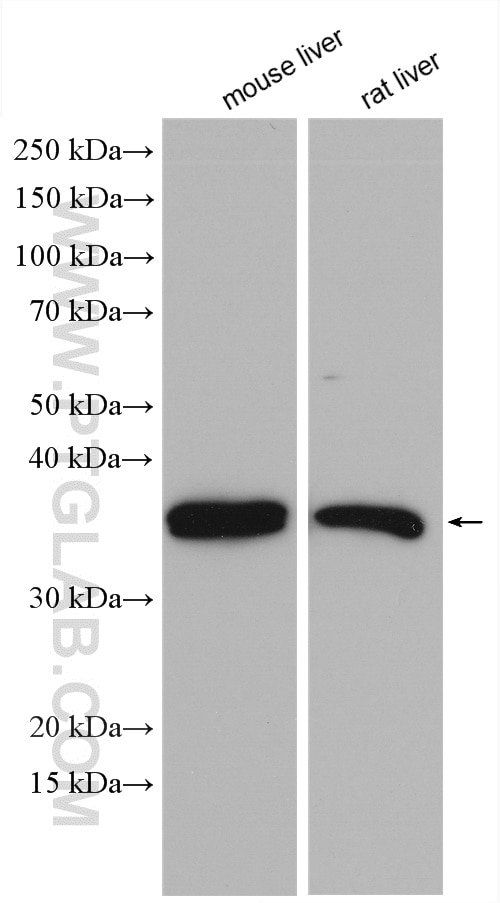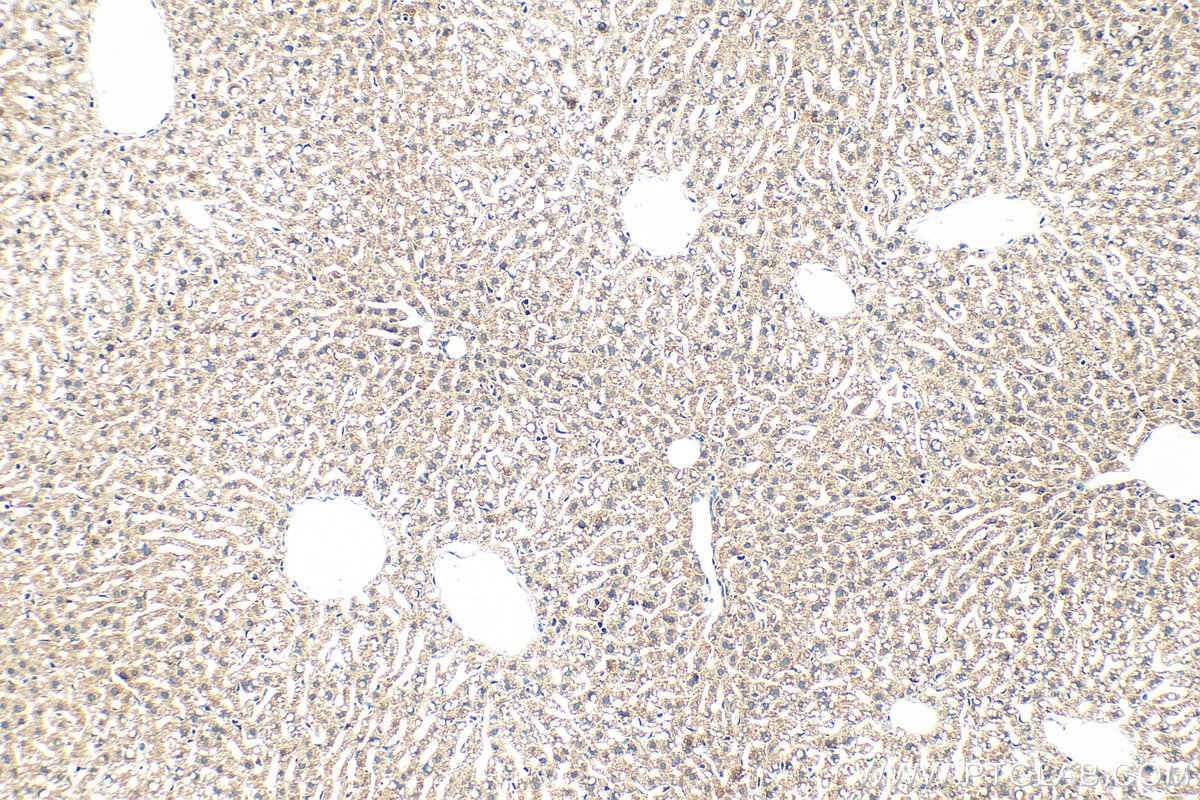Anticorps Polyclonal de lapin anti-INSIG1
INSIG1 Polyclonal Antibody for WB, IHC, IF/ICC, ELISA
Hôte / Isotype
Lapin / IgG
Réactivité testée
Humain, rat, souris et plus (2)
Applications
WB, IHC, IF/ICC, ELISA
Conjugaison
Non conjugué
N° de cat : 55282-1-AP
Synonymes
Galerie de données de validation
Applications testées
| Résultats positifs en WB | tissu hépatique de souris, tissu hépatique de rat |
| Résultats positifs en IHC | tissu hépatique de souris, il est suggéré de démasquer l'antigène avec un tampon de TE buffer pH 9.0; (*) À défaut, 'le démasquage de l'antigène peut être 'effectué avec un tampon citrate pH 6,0. |
| Résultats positifs en IF/ICC | cellules HEK-293, |
Dilution recommandée
| Application | Dilution |
|---|---|
| Western Blot (WB) | WB : 1:1000-1:6000 |
| Immunohistochimie (IHC) | IHC : 1:250-1:1000 |
| Immunofluorescence (IF)/ICC | IF/ICC : 1:50-1:500 |
| It is recommended that this reagent should be titrated in each testing system to obtain optimal results. | |
| Sample-dependent, check data in validation data gallery | |
Applications publiées
| WB | See 8 publications below |
| IHC | See 1 publications below |
| IF | See 3 publications below |
Informations sur le produit
55282-1-AP cible INSIG1 dans les applications de WB, IHC, IF/ICC, ELISA et montre une réactivité avec des échantillons Humain, rat, souris
| Réactivité | Humain, rat, souris |
| Réactivité citée | rat, Humain, poulet, singe, souris |
| Hôte / Isotype | Lapin / IgG |
| Clonalité | Polyclonal |
| Type | Anticorps |
| Immunogène | Peptide |
| Nom complet | insulin induced gene 1 |
| Masse moléculaire calculée | 30 kDa |
| Poids moléculaire observé | 35 kDa |
| Numéro d’acquisition GenBank | NM_005542 |
| Symbole du gène | INSIG1 |
| Identification du gène (NCBI) | 3638 |
| Conjugaison | Non conjugué |
| Forme | Liquide |
| Méthode de purification | Purification par affinité contre l'antigène |
| Tampon de stockage | PBS with 0.02% sodium azide and 50% glycerol |
| Conditions de stockage | Stocker à -20°C. Stable pendant un an après l'expédition. L'aliquotage n'est pas nécessaire pour le stockage à -20oC Les 20ul contiennent 0,1% de BSA. |
Informations générales
Insulin-induced genes (INSIGs), which consist of two isoforms (INSIG1 and INSIG2), are representative endoplasmic reticulum (ER)-resident oxysterol-binding proteins (OSBPs). INSIG1 is part of negative regulatory feedback, acting as a brake on SREBP transcriptional function (PMID: 23919961). INSIG1 also has a secondary function mediating sterolaccelerated proteolytic degradation of HMG CoA reductase, thus impacting the mevalonate pathway. Suppression of INSIG1 function promotes hepatic lipid remodelling and restrains NASH (non-alcoholic steatohepatitis) progression(PMID: 33722690).
Protocole
| Product Specific Protocols | |
|---|---|
| WB protocol for INSIG1 antibody 55282-1-AP | Download protocol |
| IHC protocol for INSIG1 antibody 55282-1-AP | Download protocol |
| IF protocol for INSIG1 antibody 55282-1-AP | Download protocol |
| Standard Protocols | |
|---|---|
| Click here to view our Standard Protocols |
Publications
| Species | Application | Title |
|---|---|---|
Cell Death Differ Ubiquitination of NLRP3 by gp78/Insig-1 restrains NLRP3 inflammasome activation. | ||
Front Pharmacol Acacetin protects against depression-associated dry eye disease by regulating ubiquitination of NLRP3 through gp78 signal | ||
Poult Sci Functional and miRNA regulatory characteristics of INSIG genes highlight the key role of lipid synthesis in the liver of chicken (Gallus gallus) | ||
FASEB J Dickkopf-1 promotes vascular smooth muscle cell foam cell formation and atherosclerosis development through CYP4A11/SREBP2/ABCA1 | ||
Metabolism miR-32-5p induces hepatic steatosis and hyperlipidemia by triggering de novo lipogenesis | ||
Redox Biol Excessive SOX8 reprograms energy and iron metabolism to prime hepatocellular carcinoma for ferroptosis |
Avis
The reviews below have been submitted by verified Proteintech customers who received an incentive for providing their feedback.
FH Zach (Verified Customer) (09-12-2025) | Did not detect endogenous protein but detected transgenically overexpressed ones.
|





